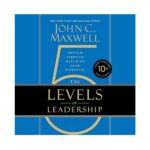LISTEN NOW
Outline: The 5 Levels of Leadership by John C. Maxwell
Outline
Expand to Read ...
Key Concept
Leadership is equated with influence. Maxwell outlines five levels of leadership, each building upon the previous one, representing a progression of influence and effectiveness:
- Position: Title-based influence—people follow because they have to.
- Permission: Relationship-based influence—people follow because they trust and respect you.
- Production: Results-based influence—people follow because of what you accomplish.
- People Development: Empowerment-based influence—people follow because you’ve developed them into leaders.
- Pinnacle: Legacy-based influence—people follow because of your lasting reputation for developing strong leaders and organizations.
The 5 Levels of Leadership
Level 1: Title-Based Leadership
- Description:
- Leadership is tied to your position or title.
- People follow you because they are obligated, not inspired.
- Opportunity:
- Begin defining your personal leadership brand.
- Influence others and impact the organization beyond the authority of your title.
- Potential Pitfall:
- Relying solely on your position to lead, which can stifle growth and innovation.
- Next Steps for Growth:
- Build relationships: Engage with team members and understand their motivations.
- Seek mentorship: Learn from a leader aligned with your goals.
Level 2: Relationship-Based Leadership
- Description:
- Leadership is based on trust and relationships.
- People follow you because they want to, not because they have to.
- Opportunity:
- Foster a positive work environment with open communication and mutual respect.
- Build energy and morale through authentic connections.
- Potential Pitfall:
- Overemphasizing relationships at the expense of results, potentially frustrating high achievers.
- Next Steps for Growth:
- Develop self-awareness: Acknowledge strengths, weaknesses, and areas for improvement.
- Like people: Start from a place of positivity and seek genuine connections.
- Balance relationships and accountability: Provide constructive feedback and set clear boundaries.
Level 3: Results-Based Leadership
- Description:
- Leadership is defined by achievements and results.
- People follow you because you lead by example and deliver outcomes.
- Opportunity:
- Inspire team members by modeling self-discipline, hard work, and productivity.
- Build momentum by attracting and empowering talented team members.
- Potential Pitfall:
- Neglecting relationships in favor of results, leading to a return to Level 1 leadership.
- Next Steps for Growth:
- Align with the organization’s vision: Communicate it clearly and creatively.
- Develop the team: Foster complementary strengths and provide feedback.
- Prioritize effectively: Use the Pareto Principle (focus on the top 20% of tasks that yield 80% of results).
- Sustain momentum: Be proactive, initiate change, and continually push for progress.
Level 4: Empowerment-Based Leadership
- Description:
- Leadership focuses on developing others into leaders.
- People follow you because you’ve invested in their growth and potential.
- Opportunity:
- Increase the organization’s potential by building skilled and dedicated employees.
- Free up your time to focus on strategy and innovation.
- Potential Pitfall:
- Struggling with insecurity, ego, or reluctance to delegate authority.
- Next Steps for Growth:
- Recruit and train the best: Prioritize potential and provide tools for growth.
- Focus on high-potential individuals: Dedicate time to developing the top 20% of your team.
- Tailor mentorship: Create personalized development plans with clear guidelines.
- Stay approachable: Cultivate humility and transparency to foster learning.
Level 5: Legacy-Based Leadership
- Description:
- Leadership is rooted in legacy and reputation.
- People follow you for the enduring impact you’ve made on individuals and organizations.
- Opportunity:
- Leave behind a thriving organization sustained by well-trained leaders.
- Make a lasting, positive impact on people and systems.
- Potential Pitfall:
- Overconfidence or neglecting core responsibilities due to distractions.
- Next Steps for Growth:
- Develop other leaders: Provide resources and opportunities for growth.
- Build a leadership incubator: Create an environment where leadership flourishes.
- Focus on possibilities: Innovate and drive transformative changes.
- Surround yourself with accountability: Rely on an inner circle of trusted advisors to remain grounded.
- Define your legacy: Reflect on how you want to be remembered and take steps toward creating that impact.
Conclusion
Each level of leadership builds on the previous one. Leaders progress by developing relationships, achieving results, empowering others, and ultimately creating a legacy. By following these steps, individuals can maximize their leadership potential and inspire lasting change.

 Buy on Amazon
Buy on Amazon